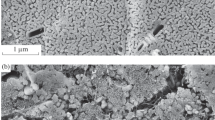Abstract
The thermal properties of the quaternary glass-forming CaO–MgO–Al2O3–SiO2 system were evaluated. Different glass compositions with an expected liquidus temperature—the lowest temperature at which both the crystal phase and the melt are thermodynamically stable—below 1300 °C were melted from pure raw materials. Each oxide concentration did not deviate by more than ±3 mol% from that of the centre glass composition of 61.2 SiO2, 26.3 CaO, 8.6 Al2O3 and 3.8 MgO. Viscosity data and the liquidus temperatures were determined, as well as the exact compositions of the respective glasses by X-ray fluorescence. It was of special interest for this study, whether small compositional changes have a stronger influence on T Liq or T 3. The T 3-values, which are the temperatures attributed to a viscosity of 103 dPa s—showed a much larger variation and are in the range from 1263 to 1363 °C. An exchange of the network formers Al2O3 or SiO2 by network modifiers CaO and MgO resulted in a decrease in viscosity. The effect of MgO was also shown by a comparison with glasses of similar compositions but without any MgO. The exchange between Al2O3 and SiO2 did not show a significant difference in viscosity whereas the substitution of CaO by MgO increased the viscosity. The liquidus temperature varied between 1137 and 1192 °C—less than expected for a composition close to an eutectic system.





Similar content being viewed by others
References
Loewenstein KL (1993) The manufacturing technology of continuous glass fibres, 3rd edn. Elsevier, Amsterdam
Wallenberger FT (2010) Design of energy friendly glass fibers. In: Wallenberger FT, Bingham PA (eds) Fiberglass and glass technology: energy friendly compositions and applications. Springer, New York
ASTM D578 (2013) Standard specification for glass fibre strands. ASTM International, West Conshohocken. doi:10.1520/D578. www.astm.org
Cable M, Smedley JW (1987) Liquidus temperatures and melting characteristics of some earlier container glasses. Glass Technol 28(2):94–98
Veit U, Houet Y, Laurent D, Rüssel C (2015) Liquidus temperatures of calcium magnesium alumosilicate glass-forming compositions determined via gradient furnace and from the melting peak by differential thermal analysis. Thermochim Acta 618:1–5
Wallenberger FT, Smrcek A (2010) The liquidus temperature; its critical role in glass manufacturing. Int J Appl Glass Sci 1(2):151–163. doi:10.1111/j.2041-1294.2010.00015.x
Beerkens RGC, Conradt R (2008) Round robin test on liquidus temperature of soda–lime–magnesia–silica float glass samples. Eur J Glass Sci Technol A 49(5):205–212
Fluegel A (2007) Glass viscosity calculation based on a global statistical modelling approach. Eur J Glass Sci Technol A 48(1):13–30
Paul A (1990) Chemistry of glasses. Chapman and Hall, London/New York
Wallenberger FT, Hicks RJ, Bierhals AT (2004) Design of environmentally friendly fiberglass compositions: ternary eutectic SiO2–Al2O3–CaO and related compositions, structures and properties. J Non-Cryst Solids 349:377–387. doi:10.1016/j.jnoncrysol.2004.08.215
Abel BM, Mauro JC, Smedskjaer MM et al (2013) Liquidus surface of MgO–CaO–Al2O3–SiO2 glass-forming systems. J Non-Cryst Solids 363:39–45. doi:10.1016/j.jnoncrysol.2012.12.020
Kauzmann W (1948) The nature of the glassy state and the behavior of liquids at low temperatures. Chem Rev 43(2):219–256
Alibert M (1995) Slag atlas, 2nd edn. Verlag Stahleisen GmbH, Düsseldorf
Walter G, Vogel J, Hoppe U, Hartmann P (2003) Structural study of magnesium polyphosphate glasses. J Non-Cryst Solids 320(1–3):210–222
Koch K, Trömel G, Heinz G (1975) Das Zustandsdiagramm Al2O3–CaO–MgO–SiO2 in polythermischer Darstellung. Tonind.-Ztg Keram Rundsch 99(3):57–62
Veit U, Rüssel C (2016) Viscosity and liquidus temperature of ternary glasses close to the eutectic composition in the CaO–Al2O3–SiO2 system. Int J Appl Glass Sci 7(3):295–309. doi:10.1111/ijag.12191
Vogel W (1994) Glass chemistry, 2nd edn. Springer, Berlin
ASTM Standard (1990) Standard practices for measurement of liquidus temperature of glass by gradient furnace 285 method, Annual Book of ASTM Standards, C 829-81. American Society for Testing and Materials, Gaithersburg
Scholze H (1988) Glas, Natur, Struktur und Eigenschaften. Springer, Berlin
Lin C-C, Liu L-G (2006) Composition dependence of elasticity in aluminosilicate glasses. Phys Chem Miner 33:332–346. doi:10.1007/s00269-006-0084-z
Poe B, McMillan PF, Angell CA, Sato RK (1992) Al and Si coordination in SiO2–Al2O3 glasses and liquids: a study by NMR and IR spectroscopy and MD simulations. Chem Geol 96:333–349
Wang J, Cheng J-S, Deng Z-I (2013) Effect of alkali metal oxides on viscosity and crystallization of the MgO–Al2O3–SiO2 glasses. Phys B 415:34–37
Acknowledgements
This study was funded by 3B-The Fibreglass Company, S and T Center, Rue de Charneux, 59, 4651 Battice, and the Walloon Region, Belgium. We thank Yves Houet, Vincent Kempener and Dimitri Laurent for the measurement of T Liq and XRF.
Author information
Authors and Affiliations
Corresponding author
Rights and permissions
About this article
Cite this article
Veit, U., Rüssel, C. Viscosity and liquidus temperature of quaternary glasses close to an eutectic composition in the CaO–MgO–Al2O3–SiO2 system. J Mater Sci 52, 8280–8292 (2017). https://doi.org/10.1007/s10853-017-1044-3
Received:
Accepted:
Published:
Issue Date:
DOI: https://doi.org/10.1007/s10853-017-1044-3




